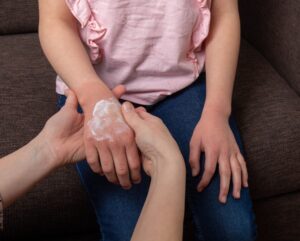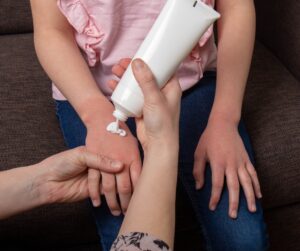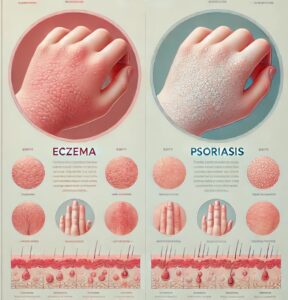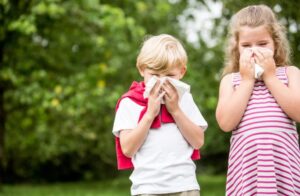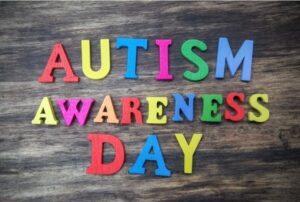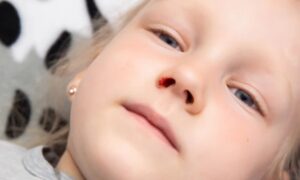Introduction
Eczema, also known as atopic dermatitis, is a common skin condition affecting children worldwide. It manifests as red, itchy, and inflamed skin, and can significantly impact a child’s quality of life. Eczema is influenced by a combination of genetic and environmental factors. Identifying common triggers and implementing preventive strategies can help manage eczema symptoms effectively. This article explores the most common triggers of eczema in children, including food allergies, climate changes, pet dander, and chemical irritants, based on recent international studies and expert recommendations.
1. Food Allergies: A Major Trigger for Eczema Flare-Ups
Food allergies are one of the most common and significant triggers for eczema in children. A study published in the Journal of Allergy and Clinical Immunology revealed that children with eczema are more likely to have food allergies compared to those without the condition (Shah et al., 2017). Common food allergens linked to eczema flare-ups include:
- Cow’s Milk: One of the most common allergens for infants and toddlers, cow’s milk protein can exacerbate eczema symptoms.
- Eggs: Egg proteins, particularly egg white, are another frequent cause of eczema flare-ups.
- Peanuts and Tree Nuts: These allergens can trigger allergic reactions and worsen eczema in children.
- Wheat and Soy: Some children with eczema are sensitive to wheat and soy proteins.
Prevention Tips:
- Gradually introduce new foods to your child to monitor potential allergic reactions.
- Consult an allergist to determine specific food allergens and avoid them.
- In some cases, a hypoallergenic diet may be recommended to manage eczema effectively.
2. Climate Change and Seasonal Variations
Environmental factors, particularly climate changes, play a crucial role in the exacerbation of eczema symptoms. According to a study in the International Journal of Dermatology (Lim et al., 2016), seasonal changes, especially cold weather and dry air, significantly impact children with eczema. Cold and dry air strips the skin of moisture, making it more susceptible to irritation and flare-ups. Conversely, hot and humid weather can also trigger sweating, which aggravates eczema symptoms.
Prevention Tips:
- In colder months, use a humidifier to maintain moisture in the air and protect your child’s skin from drying out.
- Apply moisturizers regularly to keep the skin hydrated.
- Avoid hot showers or baths, as they can further dry out the skin.
- Dress your child in soft, breathable fabrics to reduce irritation caused by sweating in warmer weather.
3. Pet Dander and Animal Allergens
Exposure to pet dander is another common environmental trigger for eczema flare-ups in children. Pet dander, which consists of tiny flakes of skin shed by cats, dogs, and other animals, can cause allergic reactions in sensitive children. According to a study in Pediatric Dermatology (Silverberg et al., 2014), children with eczema are at a higher risk of developing allergies to pet dander, leading to more severe eczema outbreaks.
Prevention Tips:
- Minimize direct contact between your child and pets, particularly if they are shedding.
- Regularly clean your home, especially pet bedding, carpets, and furniture.
- Consider using HEPA filters to reduce pet dander in the home.
- For children with severe pet allergies, it may be necessary to avoid having pets in the home altogether.
4. Chemical Irritants: Household Products and Skin Care
Chemical irritants found in household cleaning products, personal care items, and even clothing can trigger eczema flare-ups in children. Harsh chemicals, such as those found in scented soaps, detergents, and disinfectants, can strip the skin of its natural oils and lead to irritation. The British Journal of Dermatology (Baldwin et al., 2019) emphasizes that children with eczema are particularly sensitive to these irritants, which can worsen symptoms.
Prevention Tips:
- Choose fragrance-free, hypoallergenic soaps, shampoos, and lotions for your child.
- Use mild, non-toxic cleaning products that are free from harsh chemicals.
- Wash your child’s clothes with a mild detergent and avoid fabric softeners that may contain allergens.
- Limit exposure to household cleaners by ensuring proper ventilation when using them.
5. Infections: Bacterial and Viral Triggers
Infections, particularly bacterial and viral infections, can significantly worsen eczema symptoms. Staphylococcus aureus, a type of bacteria commonly found on the skin, can thrive in areas of eczema, leading to further inflammation and infection. According to a study published in The Lancet (Williams et al., 2013), these bacterial infections are common in children with eczema, contributing to persistent flare-ups and complications.
Prevention Tips:
- Keep your child’s skin clean and avoid scratching to prevent bacterial infections.
- Apply prescribed topical antibiotics if an infection occurs.
- Ensure that your child avoids contact with individuals who have contagious skin conditions or infections.
- Use gentle, antiseptic skin cleansers to prevent infection.
6. Stress and Emotional Factors
While eczema is primarily a physical condition, emotional stress and anxiety can also trigger or worsen eczema flare-ups in children. A study in the Journal of Dermatological Science (Sampson et al., 2015) found that stress can activate the immune system, which may lead to increased inflammation and skin irritation in children with eczema.
Prevention Tips:
- Help your child manage stress through relaxation techniques such as deep breathing, meditation, or mindfulness.
- Ensure a regular sleep schedule and encourage physical activities to reduce stress.
- Foster a supportive and calm environment to help your child feel safe and secure.
Conclusion
Eczema is a complex condition influenced by a variety of internal and external triggers. Identifying and managing these triggers, such as food allergies, environmental factors, pet dander, and chemical irritants, can significantly improve the quality of life for children with eczema. By following the prevention tips outlined in this article, parents can help reduce flare-ups and create a more comfortable environment for their children. However, if eczema symptoms persist or worsen, consulting a pediatric dermatologist or allergist for personalized treatment is highly recommended.
References
- Shah, R. S., et al. (2017). "Food Allergy and Atopic Dermatitis in Children: Epidemiological Trends." Journal of Allergy and Clinical Immunology, 140(2): 387-393.
- Lim, Y., et al. (2016). "Climate Change and Its Impact on Atopic Dermatitis in Children." International Journal of Dermatology, 55(6): 617-622.
- Silverberg, J. I., et al. (2014). "Pet Dander and Eczema in Children: A Review of the Literature." Pediatric Dermatology, 31(4): 425-431.
- Baldwin, A. R., et al. (2019). "Chemical Irritants and Atopic Dermatitis: A Review." British Journal of Dermatology, 180(3): 467-473.
- Williams, H. C., et al. (2013). "Bacterial Infections and Atopic Dermatitis in Children: A Systematic Review." The Lancet, 381(9871): 614-623.
- Sampson, H. A., et al. (2015). "The Role of Stress in the Worsening of Eczema." Journal of Dermatological Science, 79(3): 237-243.





